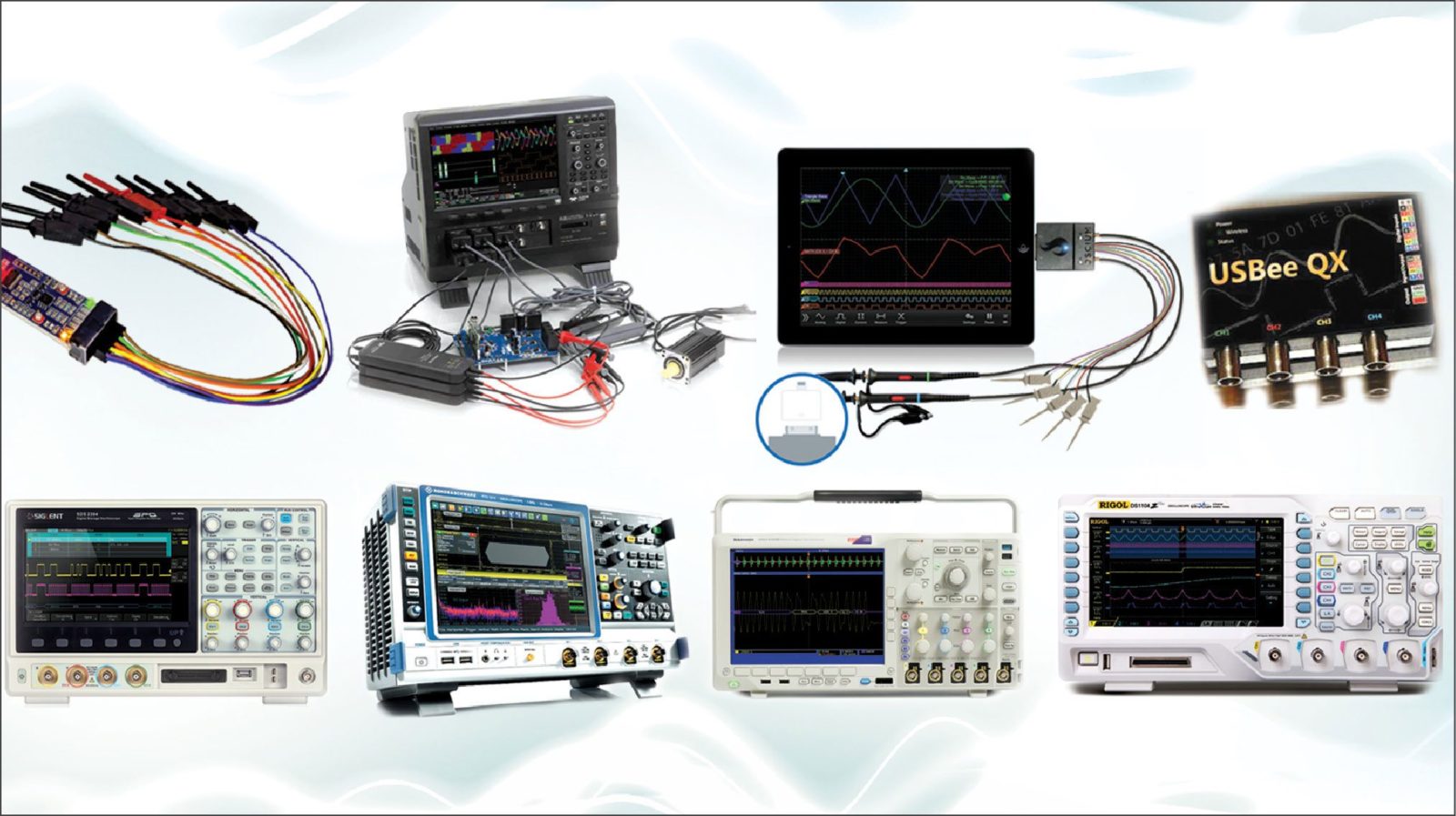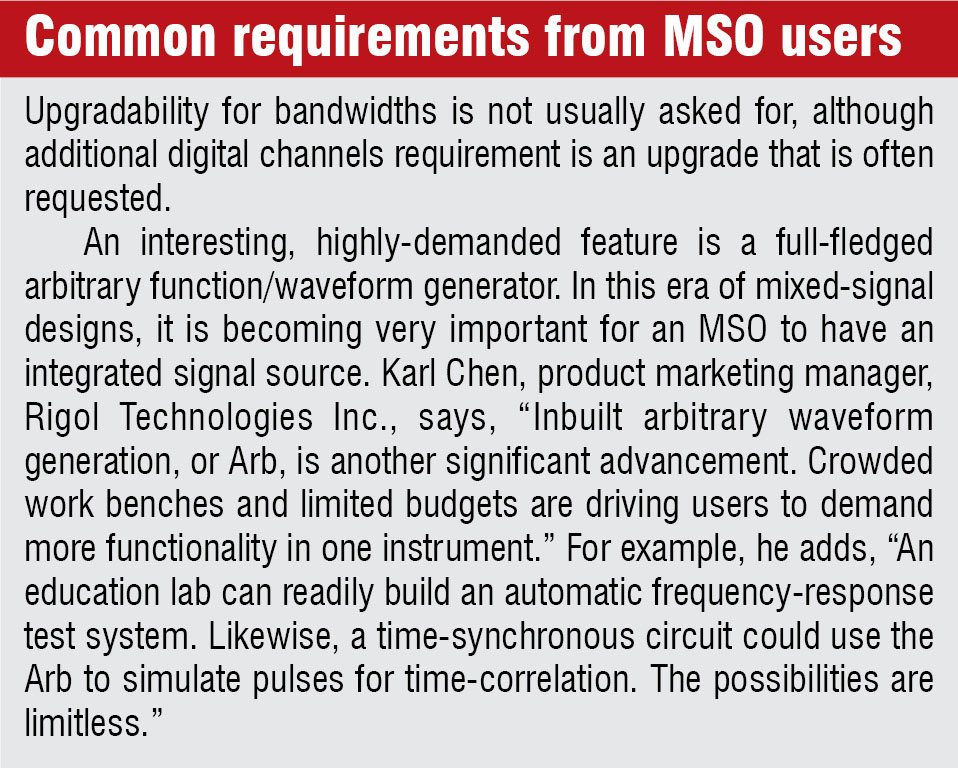Engineers, especially those working on embedded designs, bank on mixed-signal oscilloscopes (MSOs) right from the prototype stage to product testing. Embedded system designers debug their designs with analogue- and digital-channel capabilities in these oscilloscopes, which also provide a variety of triggering options. Let us take a look at the new capabilities added in these MSOs.
Faster, wider, higher, deeper: four buzzwords in MSOs
As embedded designs continue to grow speedily in numbers, manufacturers are continuously evolving their MSOs accordingly. With new applications emerging in the Internet of Things (IoT), wireless and various semiconductor technologies, MSOs are playing an important tool for debugging. Today’s oscilloscopes come with faster sampling rates, wider channel selection, higher resolutions and deep memory.
For instance, HDO8000 series introduced by Teledyne LeCroy has eight analogue input channels with 12-bit resolution. This allows engineers to view clean and crisp signals in greater detail, post debugging using digital channels. Often signals are lost in noise. But with high resolution, engineers can be sure of clearly seeing such signals, thereby improving the overall debug and analysis process.

RTO and RTE series of digital-storage oscilloscopes (DSOs) from Rohde & Schwarz, which also have the option of mixed-signal, provide high-resolution capabilities with their monolithic analogue-to-digital (A/D) converters that make acquisitions up to 16-bit resolution possible.
Engineers are always on the look out for more analogue channels in a scope. Eight analogue channels provide great flexibility to an engineer working on complex embedded designs. Although, more analogue channels on an MSO makes the device more expensive. Apart from Teledyne LeCroy’s HDO8000 series of MSOs, another test and measurement (T&M) vendor, Yokogawa, provides eight analogue channels in its DLM4000 series of MSOs.
Such MSOs, with a wide selection of channels, are ideal for professionals debugging high-power power electronics, automotive electronics and complex embedded as well as mechatronic designs. A unique ability of DLM400 series is that the eighth analogue channel comes with Flex MSO, a feature that converts it to an 8-bit logic analyser with the push of a button.
With more analogue channels and higher resolutions, deep record lengths is an equally important feature. T&M vendors are offering MSOs with deep memory typically ranging from 150Mpts per channel to 250Mpts per channel. The sampling rate for MSOs usually range from 1.5GSa/s to 4Gsa/s.

CAN FD-enabled MSOs
Most of the known MSO vendors are steadily incorporating support for controller area network with flexible data rate (CAN FD) data frames by providing an additional trigger capability for better analysis of traffic in the CAN FD network.
After Teledyne LeCroy, Keysight and Rohde & Schwarz, Yokogawa has integrated support for CAN FD in their DLM2000 and DLM4000 series of MSOs. Evolution of more complex and advanced vehicular control systems has a proportional effect on the amount of traffic inside the CAN network. Therefore it is important for MSOs to have the ability to provide engineers with dedicated triggers and functionalities to boost the analysis and debugging process.
Apart from triggers and search functions for CAN FD, it is important for the MSO to have high memory depth as it makes it easier for the designer to handle extended data frames.
Some other oscilloscopes that support CAN FD are Infinii Vision 3000T X-series and 4000T X-series from Keysight Technologies, Teledyne LeCroy’s CAN FD TDM oscilloscopes, and RTE and RTO oscilloscopes from Rohde & Schwarz.
MSOs powered with PAM-4 analysis capability
 Many known oscilloscope manufacturers have recently introduced pulse amplitude modulation (PAM-4) analysis capability in their range of MSOs.
Many known oscilloscope manufacturers have recently introduced pulse amplitude modulation (PAM-4) analysis capability in their range of MSOs.
Mobile computing applications are requiring ever-increasing Internet speeds as well as improved Internet infrastructure. To enable this, very-high-speed connectivity among server systems is absolutely necessary.
Non-return-to-zero (NRZ) encoding is mostly used for modulation in conventional communication methods. Industry experts feel NRZ will not function in a 56Gbit/s environment. Hence, one solution for this problem is to change the technique from NRZ to PAM. This would allow engineers to significantly expand the amount of data these can transmit across high-speed digital communication links. Many industry standards bodies are actively promoting PAM-4 technology.
PAM-4 signalling helps engineers to address design and measurement challenges swiftly and achieve faster time-to-market. Vendors usually provide an additional software tool that can be combined with particular models of MSOs to activate PAM-4 analysis capability.
Recently, Keysight introduced Keysight N8827A PAM-4 analysis software (for V- and Z-series oscilloscopes) and N8827B PAM-4 analysis software (for S-series oscilloscopes), which engineers can use to perform a complete analysis of electrical PAM-4 signals.
Teledyne LeCroy too released a set of tools for similar analysis and they claim to be the only manufacturer who offer a software that compares jitter, eye and noise measurements on up to four lanes, simultaneously.
Serial-bus triggering trickling down to low-end MSOs
Another trend in MSOs is that serial-bus triggering and decoding is moving down to low-end MSOs. Earlier, only high-end MSOs had the capability of serial triggering, but it is slowly trickling down to basic MSOs offering 70MHz and 100MHz bandwidths.






